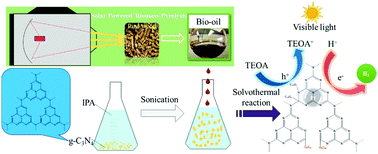Surface modification of porous g-C3N4 materials using a waste product for enhanced photocatalytic performance under visible light†
Abstract
A facile and low-cost g-C3N4 surface modification approach using a biomass-derived liquid product is proposed in this work. Through the incorporation of renewable and sustainable bio-oil that is generated from a solar powered waste biomass pyrolysis, the surface functionality of a pristine g-C3N4 material is modified with functional groups that are of electron-withdrawing character, leading to the improvement of the photocatalytic hydrogen evolution rate for the modified C3N4 sample. At low reaction temperature (120 °C), the sample is modified through a cleavage of C–N bonds between three heptazine fragments and tertiary nitrogen, followed by the bonding of oxygenated functional groups. As the reaction temperature increases further to a higher temperature (180 °C), a partial de-aromatization of the triazine network in the C3N4 sample due to the intercalation of functional groups from this post-synthesis bio-oil modification is further observed. The remarkable hydrogen evolution rate of the modified C3N4 sample higher than that of pristine g-C3N4 is observed, attributed to the synergistic effects of the extended visible light response, better separation of the photogenerated charge carriers and the enlarged specific surface area.



 Please wait while we load your content...
Please wait while we load your content...